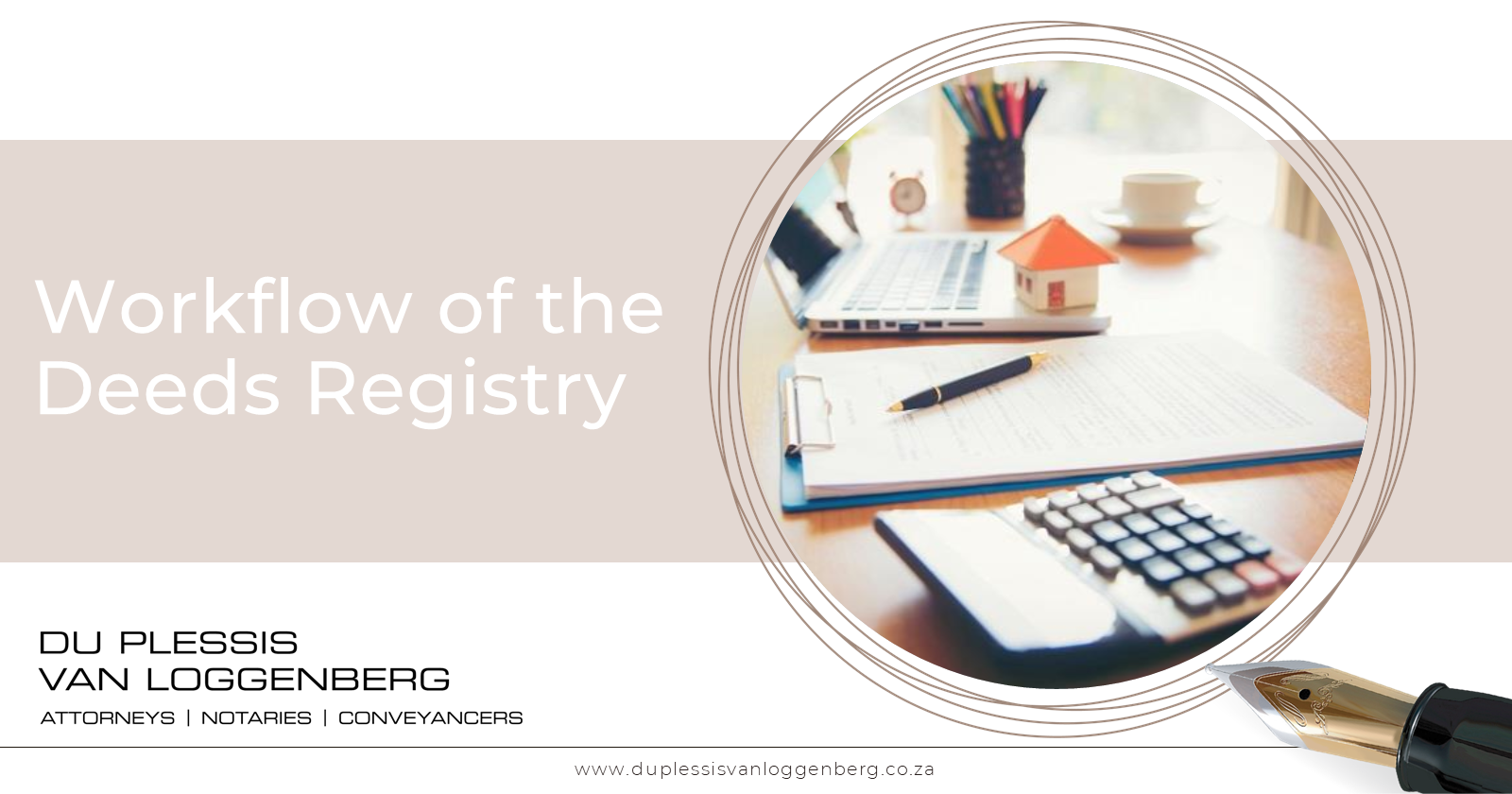
Understanding the workflow of the Deeds Registry
12/10/2022 - By Tiffany MareThe Deeds Office
The Deeds Registry is an entity of the Department of Rural Development and Land Reform. There are 11 deeds registries located in nine different provinces and are overseen by the Office of the Chief Registrar of Deeds.
The duties and powers of the Deeds Registry is to register title deeds and documents, manage and maintain the country's land register, provide information related to registrations and archive the records.
The Registrar is assisted by deputy and assistant registrars of deeds. These officers are in turn assisted by chief examiners, examiners and administrative staff.
Our land registration stemmed from the Transfer duty Laws in Holland in 1598 and was introduced into the cape where it then evolved independently. Due to our advanced system, our land registration system is generally known as one of the best developed and most precise systems in the world.
We will now explore the different processes and stages our documents go through at the Deeds Registry. Please note that the below sequence and time frame is merely a guideline and may differ between the different Deeds Registries. The number of deeds received may affect the number of days it takes to get through the Deeds Registries system.
Day 1
Documents are prepared and signed by the Conveyancer. The Conveyancer then lodges the documents at the lodgement counter at the deeds registry.
Depending on how each deeds offices practices, the deeds are lodged in specific colour covers, with specific codes depending on their unique transaction.
If there are several transactions to be registered simultaneously, the Conveyancers must make the necessary arrangements with the other firms involved to coordinate the lodgement date in order to link the documents accordingly. The Conveyancers are required to link the documents together before lodging. For example, a transfer, a bond cancellation and the registration of a new bond.
The lodgement counter staff check and date the linked lodgement covers and send them to the Data Section, where computer printouts of the parties and properties concerned are obtained and filed in the relevant lodgement covers.
The printouts could include insolvency/marital status of the parties or interdicts that may be recorded against the properties.
The documents are then sent to the distribution room, where the documents are divided between the examiners according to their daily quota of deeds to be examined.
Day 2
The junior examiners collect their deeds from the distribution room. They generally, examine the deeds, check for interdicts and place any necessary endorsements on the deeds. They will make notes to the Conveyancer in respect to any errors they may have picked up.
Day 3
The junior examiners return their deeds to the distribution room for the re-distribution to the senior examiners. The senior examiners collect their quota of deeds to examine, ensuring that any applicable Acts, case law, rulings have been applied accordingly. Any errors will be noted for the Conveyancers attention. The senior examiner will either pass or reject the documents depending on the severity of the errors recorded.
Day 4
The assistant registrar will monitor the standards of the documents lodged and ensure that she agrees with the senior examiners notes/decisions to reject or pass the documents. Deeds which are rejected will be sent to the delivery counter for the Conveyancers attention. Deeds which have been passed will be sent to the preparation room for the Conveyancers attention.
Day 5
On preparation, the linked batches are now separated and each firm is given an opportunity to comply with any notes raised by the examiners.
Once the Conveyancer has fully complied with the note, he may approach the examiner to request the removal thereof. Depending on the Deeds Office, Conveyancers are usually given +/- 3 days to attend to the notes.
If the notes are not removed timeously, the batch of documents will be rejected and sent to the delivery counter for the Conveyancers attention. However, depending on the circumstances, Conveyancers may request special permission for extra days to attend thereto.
Once all notes are removed and the batch has been put forward, the data clerks will do a final check for any interdicts they have received since their first data check. If no new interdicts have been received, the deeds are sent to the execution room where they are again separated for each Conveyancers attention.
Day 6-7
Deeds are executed before the registrar of deeds. Execution means that the Conveyancer who is duly authorized by the Power of Attorney signed by the owner of the property has signed the deed before the registrar. Execution also includes the registrars signature to the documents.
Conveyancers are expected to appear in person before the Registrar to hand in the linked documents for registration. No clerk or employee of the Conveyancer may perform this function.
Deeds which are not executed timeously are rejected and sent to the delivery room for the Conveyancers attention.
Day 7
On the day of execution of the deeds and the registration thereof, the batches are sent to the numbering section, where the deeds are numbered and given specific codes, depending on the transaction. The official seal of the registrar is affixed to the pages of the deeds on which the registrars signature appears.
Day 8-9
The deeds are now sent to the data section where all the information of the transaction is captured.
Day 10
Deeds are sent for final checking. The deeds are carefully scrutinised to ensure that all endorsements have been signed and numbered correctly, all documents are enclosed and all notes have been dealt with.
Day 11
The documents are scanned or microfilmed. These are then stored in the deeds registries records.
Day 12
The Office of the Surveyor-General is notified of any transactions that require updating on their records.
Day 13-14
The documents are sent to the delivery room for the Conveyancers attention. The Conveyancer may then send the deed to their clients or banks, depending on the transaction.
